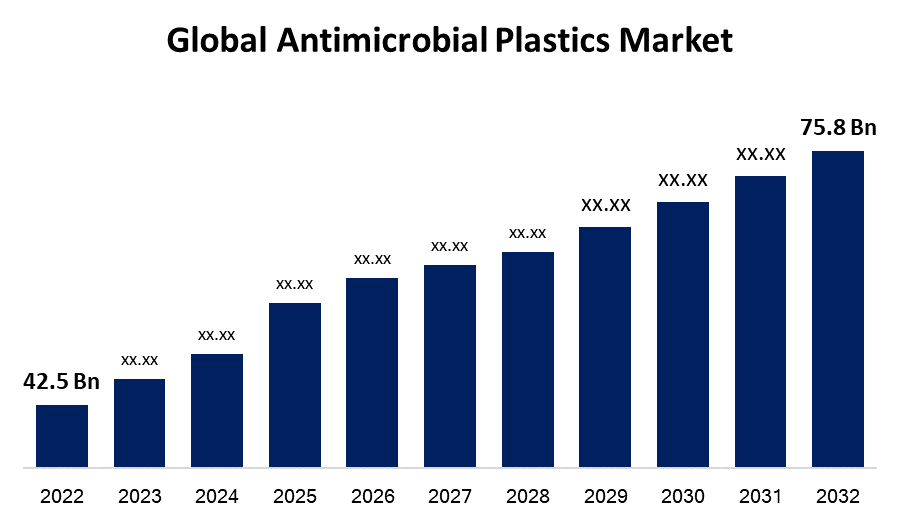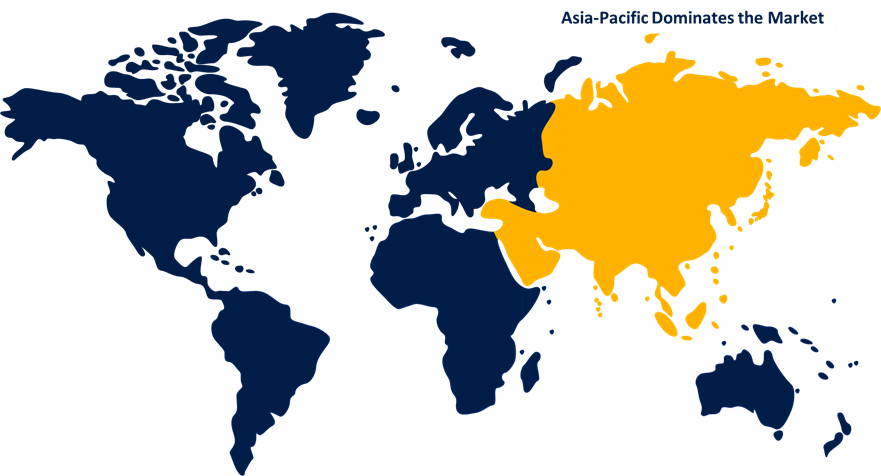Global Antimicrobial Plastics Market Size To Grow USD 75.8 Billion By 2032 | CAGR of 8.6%
Category: Chemicals & MaterialsGlobal Antimicrobial Plastics Market worth USD 75.8 Billion By 2032
According to a research report published by Spherical Insights & Consulting, the Global Antimicrobial Plastics Market Size To Grow from USD 42.5 Billion in 2022 to USD 75.8 Billion by 2032, at a Compound Annual Growth Rate CAGR of 8.6% during the forecast period.

Get more details on this report -
Browse key industry insights spread across 200 pages with 110 Market data tables and figures & charts from the report on the "Global Antimicrobial Plastics Market Size, Share, and COVID-19 Impact, By Product (Commodity Plastics, Engineering Plastics, High-performance Plastics), By End User (Medical Healthcare, Packaging, Electrical Electronics, Automotive, Building Construction, Food Beverage, Others), by Region (North America, Europe, Asia-Pacific, Latin America, Middle East, and Africa), Analysis and Forecast 2022 – 2032." Get Detailed Report Description Here: https://www.sphericalinsights.com/reports/antimicrobial-plastics-market
To stop the growth of microorganisms like bacteria, fungi, and viruses, antimicrobial plastics have been treated or changed. Antimicrobial additives or coatings on these plastics prevent dangerous germs from developing and thriving on their surfaces. The antimicrobial properties of these plastics can be advantageous in a range of circumstances when it's vital to maintain cleanliness, prevent the transmission of diseases, or prevent the development of harmful microorganisms. Antimicrobial plastics are extensively used in healthcare buildings, hospital equipment, and medical gadgets. These materials increase patient safety by reducing the incidence of healthcare-associated infections by suppressing bacterial growth on surfaces.
COVID 19 Impact
The COVID-19 epidemic has had a substantial influence on a wide range of businesses, including the antimicrobial plastics market. Antimicrobial polymers are designed to prevent the growth of microorganisms such as bacteria, viruses, and fungi. These plastics are used in a variety of products, such as packaging, medical facilities, autos, and consumer goods. The pandemic increased demand for antibacterial polymers in the healthcare sector. These plastics have been widely used in the production of medical equipment, personal protective equipment (PPE), and hospital surfaces. The demand for better cleaning procedures in healthcare settings has pushed the demand for antimicrobial materials. The antimicrobial plastics business, like many other industries, encountered supply chain issues as a result of lockdowns, travel restrictions, and reduced manufacturing capacity.
As people's knowledge of hygiene and the value of infection prevention has grown, so has the need for items that stop microbe development. Antimicrobial polymers provide a useful response to this demand because of their ongoing defence against bacteria, viruses, and other diseases. The healthcare industry has dominated the antimicrobial plastics market. Antimicrobial polymers are extensively used in medical devices, equipment, and surfaces in healthcare facilities to reduce the incidence of healthcare-associated infections. As hospitals and clinics concentrate greater emphasis on infection control, there is expected to be an increase in the need for antimicrobial polymers in the healthcare sector.
One of the problems is ensuring that polymers' antibacterial properties remain strong and effective over time. Over time, antimicrobial substances may lose some of their potency, necessitating frequent replacement or maintenance. Antimicrobial polymers that can function effectively for the entirety of the product's lifecycle must be developed in order to address this issue. Antimicrobial polymers are subject to rules and regulations to ensure their efficacy and security. Compliance with these regulations can be challenging and time-consuming, especially with the introduction of new antimicrobial technologies and additives. Businesses must manage regulatory regulations to make sure their products adhere to the needed standards. antibacterial plastics may cost more than regular plastics because they include antibacterial compounds and require additional production steps.
Product Insights
Commodity Plastics accounted the largest market share over the forecast period
On the basis of product, the global antimicrobial plastics market is segmented into Commodity Plastics, Engineering Plastics, High-performance Plastics. Among these, commodity plastics accounted the largest market share over the forecast period. The consumer market's need for antimicrobial polymers has been spurred by a variety of factors. First of all, consumers have raised their awareness of health and cleanliness, especially in light of the COVID-19 pandemic. This has led to an increase in the demand for antimicrobial products that can limit the spread of bacteria and germs. Food packaging with antimicrobial properties has drawn increased attention as a strategy to prolong product shelf life and maintain freshness. As a result, plastic packaging materials now feature antimicrobial films and coatings.
End Use Insights
The healthcare segment is dominating the market over the forecast period
Based on the end user, the global antimicrobial plastics market is segmented into building and construction, automotive and transportation, packaging, healthcare, food and beverage, textile, consumer goods, and others. Among these, the healthcare segment is dominating the market over the forecast period. Healthcare-associated infections (HAIs) are a major concern for hospitals and other medical settings. Antimicrobial polymers lower the frequency of HAIs by limiting the growth of bacteria and other germs on surfaces and equipment. Due to the growth of healthcare facilities, particularly in emerging nations, the need for antimicrobial polymers has increased for a number of applications, including hospital furniture and medical equipment.
Regional Insights
Asia Pacific holds the highest market share over the forecast period

Get more details on this report -
Asia Pacific region is dominating the market with the highest market share over the forecast period. Due to the region's massive population, increasing urbanisation, and rising concern for infection control and cleanliness, antimicrobial polymers are in high demand across a wide range of sectors. Because of the region's growing population and rising standard of living, there is a greater need for packaged foods and processed commodities. Antimicrobial plastics are being used in food packaging more and more regularly in order to improve food safety and the shelf life of perishable foods.
Europe, on the other hand is witnessing the fastest market growth over the forecast period. Infection prevention and control are top goals in the European healthcare sector. Medical gadgets, equipment, hospital furniture, and surfaces are typically made with antimicrobial plastics to lower the risk of healthcare-associated infections (HAIs) and maintain a clean atmosphere. Due to considerations including food safety requirements, consumer demands for hygienic packaging, and the necessity to extend product shelf life, antimicrobial plastics are in increased demand in the European packaging industry. Antimicrobial plastics are used in food packaging, pharmaceutical packaging, and other uses where microbial contamination must be controlled.
Market Segment
This study forecasts revenue at global, regional, and country levels from 2019 to 2032. Spherical Insights has segmented the global Antimicrobial Plastics Market based on the below-mentioned segments:
Antimicrobial Plastics Market, Product Analysis
- Commodity Plastics
- Engineering Plastics
- High-performance Plastics
Antimicrobial Plastics Market, End User Analysis
- Building and construction
- Automotive and transportation
- Packaging
- Healthcare
- Food and beverage
- Textile
- Consumer goods
- Others
Antimicrobial Plastics Market, Regional Analysis
- North America
- US
- Canada
- Mexico
- Europe
- Germany
- Uk
- France
- Italy
- Spain
- Russia
- Rest of Europe
- Asia Pacific
- China
- Japan
- India
- South Korea
- Australia
- Rest of Asia Pacific
- South America
- Brazil
- Argentina
- Rest of South America
- Middle East & Africa
- UAE
- Saudi Arabia
- Qatar
- South Africa
- Rest of Middle East & Africa
About the Spherical Insights & Consulting
Spherical Insights & Consulting is a market research and consulting firm which provides actionable market research study, quantitative forecasting and trends analysis provides forward-looking insight especially designed for decision makers and aids ROI.
Which is catering to different industry such as financial sectors, industrial sectors, government organizations, universities, non-profits and corporations. The company's mission is to work with businesses to achieve business objectives and maintain strategic improvements.
CONTACT US:
For More Information on Your Target Market, Please Contact Us Below:
Phone: +1 303 800 4326 (the U.S.)
Phone: +91 90289 24100 (APAC)
Email: inquiry@sphericalinsights.com, sales@sphericalinsights.com
Contact Us: https://www.sphericalinsights.com/contact-us
Need help to buy this report?